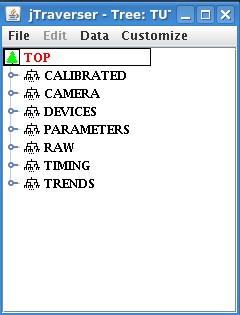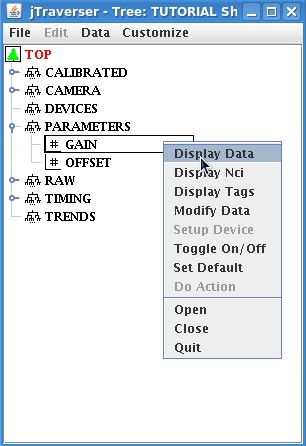From MdsWiki
| Revision as of 16:18, 24 June 2015 (edit) Manduchi (Talk | contribs) (→A quick tour over MDSplus) ← Previous diff |
Revision as of 16:29, 24 June 2015 (edit) Manduchi (Talk | contribs) (→A quick tour over MDSplus) Next diff → |
||
| Line 15: | Line 15: | ||
| A fairly complete set of data types are supportwed in MDSplus, reflecting te variety of data types dealt with in experiments. Let's have a look at the simplest types and expand PARAMETERS node.<br /> | A fairly complete set of data types are supportwed in MDSplus, reflecting te variety of data types dealt with in experiments. Let's have a look at the simplest types and expand PARAMETERS node.<br /> | ||
| [[Image:ExampleTraverser1.jpg]] <br /> | [[Image:ExampleTraverser1.jpg]] <br /> | ||
| - | The PARAMETER node has two children nodes: GAIN and OFFSET containing scalar data. You can look at their content via the popup menu as shown in the figure. | + | The PARAMETER node has two children nodes: GAIN and OFFSET containing scalar data. You can look at their content via the popup menu as shown in the figure.<br /> |
| + | More complex data types can be defined too. The list of data types supported in MDSplus is very long. More in general, any data item can be represented by an ''expression'' that is a combination of operators, numbers and refereces to other data items in the pulse file. Take for example the content of not | ||
Revision as of 16:29, 24 June 2015
A quick tour over MDSplus
In this section we'll discover the basic concepts of MDSplus through a set of working examples. We shall skip here most details, covered by the following sections of the tutorial, in order to concentrate on the main concepts.
To run the examples we need first a running installation of MDSplus. The reference system for the presented examples is Linux, although MDSplus can run also on Windows and MacOS. The preparatory steps for this overview are:
- Installation of MDSplus. MDSplus can be installedon several platform and for Linux platforms you can also download the sources and then build the system. Refer to Download Page to install MDSplus on your system.
- Installation of the running examples. The examples are available on GitHub and you can donwload them with the git command
git clone https://github.com/MDSplus/MDSplusTutorial.git
Once the examples have been downloaded from git, move to MDSplusTutorial directory:
cd MDSplusTutorial
and we are ready to start. There are two examples, activated by commands start_tutorial_1 and start_tutorial_2, respectively. Let's start with the first one and type
./start_tutorial_1
You will see the activation several graphical intefaces and a X Terminal. Let's concentrate on the following window showing a hierarchical structure.

That tree structure displays the hierarchical structure of an Experiment Model, that is the database containing all the data dealt with by the system. Data are stored in database in a hierachical organization, reflecting the normal way information is arranged in scientific applications. A MDSplus database takes two names, that refer to two different stages of the experimental sequence: the Experiment Model and the Pulse file. Consider the execution of a set of measurements that we shall call "experiment". Typically such execution produces data that need to be collected to be analyzed. Experimental data alone however may be not enough, because it is also necessary to know the configuration of all the involved devices in order to give a meaning top thje acquired values. A subset of experimental data will be therefore be represented by configuration information and will be defined before the experiment. This is the typical content of the MDSplus Experiment Model, that is a template of the full database containing configuration data. Observe that typically what happens during an experiment will depend on the actual configuration, i.e. on the data defined in the experiment model. The experiment model is then filled with expeirmental data, eventually producing a database containg the complete description of one experiment, thai is, the Pulse File. In a typical sequece of repeated experiements, the current Experiment Model is copied into a new (incomplete) pulse file just before the experiment sequence. The jTraverser application provides a graphical browser to experiment models, showing the underlying structure and the contained data.
A name and a number are associated with Pulse Files. The number is normally called shot number and refers to the instance number of the pulse file. As an experiment is typically repeated several times, a sequence of pulse files with different shot numbers will be produced as well. The conventional shot number for the Experiment Model is -1.
A fairly complete set of data types are supportwed in MDSplus, reflecting te variety of data types dealt with in experiments. Let's have a look at the simplest types and expand PARAMETERS node.

The PARAMETER node has two children nodes: GAIN and OFFSET containing scalar data. You can look at their content via the popup menu as shown in the figure.
More complex data types can be defined too. The list of data types supported in MDSplus is very long. More in general, any data item can be represented by an expression that is a combination of operators, numbers and refereces to other data items in the pulse file. Take for example the content of not